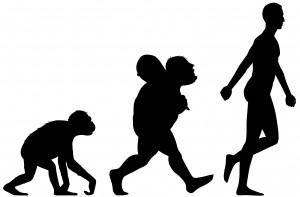 Are human beings different than they were thousands of years ago? How about hundreds of thousands or millions of years ago? Were human ancestors more ‘primitive” with less cognitive ability? Have humans evolved and become more intelligent with the incredible advance of high technology and science? Or were ancient ancestors responding to different situations with the same cognitive abilities and inventiveness?
Are human beings different than they were thousands of years ago? How about hundreds of thousands or millions of years ago? Were human ancestors more ‘primitive” with less cognitive ability? Have humans evolved and become more intelligent with the incredible advance of high technology and science? Or were ancient ancestors responding to different situations with the same cognitive abilities and inventiveness?
Another question is whether there have been other advanced civilizations that were destroyed. Some believe that in Central and South America there are airfields from an ancient civilization. 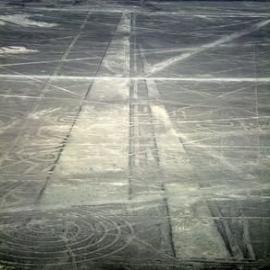 The perfectly straight Nazca Lines in Peru, parallel and intersecting like modern airport runways, were built in a pre Incan culture 2500 years ago. Other large forms at this site that could be discerned only from the air include forms of animals. Some think there are signs of ancient brain surgery. Stories about ancient high civilizations include Plato’s reference to Atlantis, Indian stories of flying machines in the time of the ancient Vedas, and lost cities in the oceans off Cuba, Pacific Islands, and the Caribbean.
The perfectly straight Nazca Lines in Peru, parallel and intersecting like modern airport runways, were built in a pre Incan culture 2500 years ago. Other large forms at this site that could be discerned only from the air include forms of animals. Some think there are signs of ancient brain surgery. Stories about ancient high civilizations include Plato’s reference to Atlantis, Indian stories of flying machines in the time of the ancient Vedas, and lost cities in the oceans off Cuba, Pacific Islands, and the Caribbean.
Despite these theories, what science really knows about the distant past comes from archaeology and genetic studies. The word of mouth stories of previous civilizations may be true, but, as has been shown from recent memory research, even current eyewitness reports are extremely fallible. Certainly, stories passed on for thousands of years are suspect.
The means of discovering what really occurred in the past is left to finding artifacts, and genetic studies, both arduous and difficult tasks. With genetic population studies estimating 20,000 to 50,000 total human ancestors on earth one million years ago, finding artifacts is equivalent to finding a needle in a haystack, with the haystack being the entire world. Despite this, remarkable findings continue to occur.
Unfortunately, before 20,000 years ago there is not a lot of information. But, recently, there are multiple discoveries that inform the discussion as to whether humans hundreds of thousands of years ago had advanced cognition. This year, for example, there were many new discoveries that push the timeline much further back for advanced cognition in human ancestors.
Millions and Billions of Years Ago
 For perspective, some evolutionary milestones include the earth cooling to the point where life was possible about 4 billion years ago, just half a billion years after its creation. Recently, signs of bacterial life have been found from around 3.5 billion years ago. Because 500 million years is not much time to evolve complex bacteria, theories of astrobiology are flourishing.
For perspective, some evolutionary milestones include the earth cooling to the point where life was possible about 4 billion years ago, just half a billion years after its creation. Recently, signs of bacterial life have been found from around 3.5 billion years ago. Because 500 million years is not much time to evolve complex bacteria, theories of astrobiology are flourishing.
At 3.4 billion years ago (bya) there is evidence of photosynthesis, and at 2 bya the mitochondrion microbe had taken up residence inside the eukaryote cell. Multi cellularity in the form of eukaryote cells forming larger organisms is found 1 bya. The first simple animals are found 600 million years ago (mya), and ancestors of insects, the arthropods, approximately 570 mya. Complex animals arrived 550 mya when there was an explosion of body types. Fish arrived 500 mya, land plants 470 mya, and amphibians 360 mya. Mammals are first found 200 mya, birds 150, and flowers 130. Dinosaurs were extinct by 65 mya. Primates fossils were first seen from 75 mya, apes 28 mya, 14 gibbons, orangutan 13, and chimps and bonobos 10. Hominia branches from chimps 7 mya.
Very Early Human Ancestors
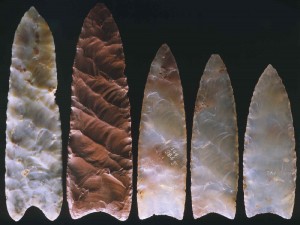 Then the human saga begins somewhere 8 to 3.5 million years ago with walking on two feet. Until recently, humans were not considered to have much evidence of creativity until perhaps 100,000 years ago with tools and 50,000 years ago with cave paintings. But, very recently, some shocking findings have dramatically changed these projections.
Then the human saga begins somewhere 8 to 3.5 million years ago with walking on two feet. Until recently, humans were not considered to have much evidence of creativity until perhaps 100,000 years ago with tools and 50,000 years ago with cave paintings. But, very recently, some shocking findings have dramatically changed these projections.
Markings on animal bones were found in Ethiopia from 3.4 million years ago. Advanced flaked tools for meat stripping appeared 2.6 million years ago. And bifacial stones appeared in Kenya 1.76 million years ago.
Until this year findings on the Flores Island near Indonesia had signs of humans from 74,000 years ago. These people were called homini (the extinct homo species) florensiensis and have been nicknamed “hobbits” because their small size.
For many years it was believed that the Islands of Crete in the Mediterranean were populated 9000 years ago.
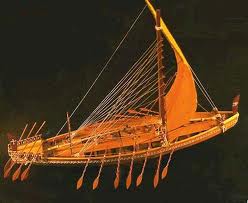 Travelling by sea is a complex behavior for humans, including building boats or rafts, navigating rough seas, and surviving in a new land. New evidence in Science shows hand axes, tetrahedral picks, and cleavers 170,000 years ago on the Island of Crete, and 110,000 years go on the Greek island Ionia. Sea faring ancestors reached Australia at least 50,000 years ago. To travel that distance at sea shows very high level cognitive abilities.
Travelling by sea is a complex behavior for humans, including building boats or rafts, navigating rough seas, and surviving in a new land. New evidence in Science shows hand axes, tetrahedral picks, and cleavers 170,000 years ago on the Island of Crete, and 110,000 years go on the Greek island Ionia. Sea faring ancestors reached Australia at least 50,000 years ago. To travel that distance at sea shows very high level cognitive abilities.
But, now evidence on Flores Island near Indonesia shows human ancestors 1.1 million years ago, a phenomenal difference. This demonstrates that human ancestors could travel from Africa at sea a million years ago. Also at the same time, humans had learned the controlled use of fire.
Another dramatic finding is that complex spears put together with multiple parts were recently found in South Africa from 500,000 years ago, 200,000 years earlier than previously thought. Multiple findings from 300,000 years ago demonstrate continuous occupation of an area of intelligent ancestors in Tanzania from that time and to 200,000 years ago. These ancestors were physically exactly similar to modern humans.
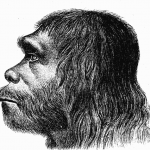 While some believe Neanderthals were cognitively inferior with greater visual and movement brain regions allowing less chance for social networking, Neanderthals 300,000 years ago were able to make a special birch bark glue, used for fastening stone to wood handles. This shows chemical knowledge.
While some believe Neanderthals were cognitively inferior with greater visual and movement brain regions allowing less chance for social networking, Neanderthals 300,000 years ago were able to make a special birch bark glue, used for fastening stone to wood handles. This shows chemical knowledge.
Activity at 164,000 years ago demonstrated knowledge of chemistry using low-grade fire to change the silcrete rock into a harder form.
Populations of Ancestors
Genetic studies show that one million years ago there were perhaps 18,000 breeding people, and possibly a 50,000 total population of human ancestors on earth. At the same time there were 21,000 chimps and 25,000 gorillas. But, later there was a drop to as low as 10,000 human ancestors because of a volcanic effect.
For a long time, there were two African populations separated by a massive drought 150,000 years ago. The two African tribes became one African society perhaps 50,000 years ago. Aside from the small migrations by sea to islands up to a million years ago, it was believed until recently that the large-scale out of Africa movement occurred perhaps around 70,000 years ago. Now it is known that the major migrations from Africa to Asia and Europe started much earlier than previously recognized. The migrations are now thought to start 130,000 years ago continuing at 95,000 years ago, with even more 62,000 years ago.
Signs of Intelligence
There are many very recent findings that show surprising intelligent abilities in ancestors for up to a million years.
The recent finding that ancestors travelled across the sea and settled in Pacific Islands 1.1 million years ago shows great intelligence, feats that would challenge most people today.
 Much of the speculation of ancient cognitive ability compared stone tools with symbolic art. Recently, however, scientific analysis has changed the older impression that stone tools were a lesser sign of intelligence. Along with difficulty in finding small spearheads, it has been even more difficult to show what cognition was needed to make these articles. New scientific methods are being used. For example analysis of the best tools from 10 sites between 284,000 to 7,000 years ago all show equivalent complex techniques used to manufacture the best tools of the era. Modern humans would find it extremely difficult to duplicate these tools. Not only were cavemen better tool technicians than modern people, they also have been shown to be able to draw four legged animals better than modern artists. They had plenty of additional time to learn.
Much of the speculation of ancient cognitive ability compared stone tools with symbolic art. Recently, however, scientific analysis has changed the older impression that stone tools were a lesser sign of intelligence. Along with difficulty in finding small spearheads, it has been even more difficult to show what cognition was needed to make these articles. New scientific methods are being used. For example analysis of the best tools from 10 sites between 284,000 to 7,000 years ago all show equivalent complex techniques used to manufacture the best tools of the era. Modern humans would find it extremely difficult to duplicate these tools. Not only were cavemen better tool technicians than modern people, they also have been shown to be able to draw four legged animals better than modern artists. They had plenty of additional time to learn.
Unfortunately, no one has found artifacts of ancestors from 8 million to about 3 million, when stone tools started to be found. It is possible these early people gathered food or their tools haven’t been found yet. More advanced tools were made 2.6 million years ago and even more advanced bifacial tools at 1.76 million.
As long ago as 500,000 years ago people were making advanced spears. Even Neanderthals, considered to be less intelligent than other homo species have to be re evaluated because 300,000 years ago they made bird bark glue fastening stone to wood handles. Other ancestors, 110,000 years ago, made engraved patterns on iron oxide, bone awls, hide clothing and shell beads. People 79,000 years ago were excellent pyro technologists and chemists. All of these feats show advanced cognition.
 Another remarkable feat occurred 77,000 years ago when people made bedding that was specifically selected from very specific trees for the ability to kill insects and fungus. These people lived near a river with mosquitoes and such bedding was critical for survival. These same people also had snares for capturing antelopes, bows and arrows, new chemical compounds, and multi ingredient glues for putting stone points on wooden shafts.
Another remarkable feat occurred 77,000 years ago when people made bedding that was specifically selected from very specific trees for the ability to kill insects and fungus. These people lived near a river with mosquitoes and such bedding was critical for survival. These same people also had snares for capturing antelopes, bows and arrows, new chemical compounds, and multi ingredient glues for putting stone points on wooden shafts.
New Findings This Past Year
The rate of scientific discovery is increasing in all fields. Despite the very difficult work involved, archaeology is no different. There were many significant findings this past year.
- A fossil of a second line of hominins living alongside Lucy was found from 3.4 million years ago. These other ancestors were more in the trees than Lucy.
- Fossils from multiple homo lineages were found in Kenya 1.87 to 1.95 million years ago.
- Evidence for controlled use of fire was found in South Africa one million years ago, 600,000 years earlier than previously thought.
- Advanced tools with multiple parts for spears with stone tips were found 500,000 years ago, 200,000 years earlier than previously thought.
- Possibly 50 Neanderthal cave paintings in Spain from approximately 40,000 years ago were found. Despite impressions of limited skills in Neanderthals, they are now known to have made jewelry from teeth, shells, and feathers, and used skin painting. They also used plants for medicine.
- The Denisovans, ancient hominins, interbred with Homo sapiens. There is also evidence that Homo sapiens interbred with other species. More evidence was found for a tiny hobbit like species called homo floresiensis.
- Evidence of early Americans with tools from 13,000 years ago.
- Findings that the helpless human baby is more based on a limitation of human metabolism than the size of the pelvis.
An Inexact Timeline
Mya = Million years ago
8 to 2.5 mya
 — — Common ancestor to austraolopithecines
— — Common ancestor to austraolopithecines
— — Brain size of apes
3.mya – Marked animal bones in Ethiopia
3.4 mya – Fossils of second hominid line living alongside Lucy
— — More in the trees than Lucy
3 mya – First stone tools – Mutation – GADD45G – Larger Brain
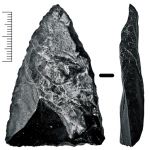 2.6 mya – More advanced flake tools for stripping meat
2.6 mya – More advanced flake tools for stripping meat
2.3 mya – Homo habilis – head 1.5 x larger
2 mya – Australopithecus sediba ate tree bark
2 mya – Mutation SRGAP2 – Increased signal processing
1.9 mya to 200 kya – Homo erectus – head 2 x larger
1.95 mya – multiple homo lineages in Kenya
 1.76 mya – Bifacial stone tools in Kenya
1.76 mya – Bifacial stone tools in Kenya
1.1 mya – Travel by sea to Flores Island, Indonesia
1 mya – Homo heidelbergensis – head 3x larger
1 mya – Mutation HAR1 – Cortex expansion
— — Mutation FOXP2 – amino acid changes
 1 mya – Burned bone and plants showing use of fire
1 mya – Burned bone and plants showing use of fire
— — Controlled use of fire South Africa
Kya = Thousand years ago
800 to 30 kya – Neanderthals and Denisovans larger heads
500 kya – Mutation – MEF2A – Delayed Synapses PFC
500 kya – Advanced composite spears
— — Stone tips on wood shafts, South Africa
200 kya – Homo sapiens sapiens
200 kya – Mutation – FOXP2 – regulation Language
170 kya – Sea travel to Crete
164 kya – Heat-treated stone tools, South Africa
130 kya – Migration from Africa to Eurasia started
110 kya – Sea travel to Ionian Greek islands
100 kya – Engraved iron oxide (ocher) South Africa
80 kya – Symbolic cave work, Blombos, South Africa
77 kya – Insect repellant bedding, South Africa
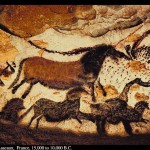 71 kya – Projectile points, South Africa
71 kya – Projectile points, South Africa
43 kya – Flutes in Germany
42 kya – 50 Neanderthal cave paintings in Spain
41 kya – Cave paintings in Spain
40 kya – Shell bead necklace, cave wall paintings many animals
— — New and better stone, bone tools in Europe
40 kya – Cave 30 cm ivory statuette of man/lion head, Germany
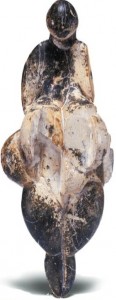
32 kya – Cave ivory animals horse, mammoth, bison, Germany
20 kya – Advanced figures, and cave paintings in Lascaux, France
20 kya – Statue, Venus of Lespugue
13 kya – Early Americans with tools
8.5 kya – Turkey, Greece – forage & farmers co exist 200 yrs.
7.5 kya – Manipulating environment – long before farming
— — Evidence of efforts for increasing plant value
7 kya – Northern Europe made cheese
5 kya – Maize in diet of Peru
Ancient Human Ancestors
Until recent discoveries there was a popular assumption of “modernity” for current humans, that only recent humans are at a high level of intelligence. But, these recent findings show much greater intelligence in human ancestors, as long ago as a million years and possibly much longer. Certainly, there is no reason to think that people hundreds of thousands of years ago were any less intelligent than we are now.
Analysis of their activities has to take into account what they needed to do to survive and the size of the population. Innovation increases when there are more workers present to contribute. A relevant new concept is “behavioral modernity” implying there are many different ways to behave as a modern human based upon the situations that people find themselves in. What would modern humans do if stranded on a desert island? It is now understood that building essential high quality stone tools and travelling on the high seas can be as significant a cognitive development as symbolic art.
The early theories tied intelligence to 40,000 years ago in Europe when many new inventions appeared including necklaces, paintings, and better tools. The theories attempt to correlate this with specific mutations. But, new data shows many significant inventions are much older.
Every living group has its own distinct circumstances. Attempting to determine what human ancestors’ living conditions were for specific theories of the evolution of modern behavior is extremely questionable. There is really no way to understand the exact circumstances of all of our ancestors through current archeological data, comparative primate behavior and observing existing native people. In reality there were many very different environments where ancestors lived. Recently, these theories called “paleofantasies” are noted to be unjustified across a wide range of peoples and behaviors.
 Many current human evolution theories need to be questioned. Despite the fact that vast quantities of refined sugar and processed foods can create big health problems, other “diseases of civilization” are not clear. Heart disease and cancer have been seen in ancient ancestors’ remains, even though ancients had much less longevity. It is really not understood what people ate in these numerous circumstances over millions of years before farming. Some genes did change over 10,000 years such as lactose digestion, but many others have not.
Many current human evolution theories need to be questioned. Despite the fact that vast quantities of refined sugar and processed foods can create big health problems, other “diseases of civilization” are not clear. Heart disease and cancer have been seen in ancient ancestors’ remains, even though ancients had much less longevity. It is really not understood what people ate in these numerous circumstances over millions of years before farming. Some genes did change over 10,000 years such as lactose digestion, but many others have not.
It now appears that ancient human ancestors had intelligence much like ours today. One set of behaviors, such as art, does not define cognition. It is also not clear what the implications are if people lived such a long time with modern intelligence.